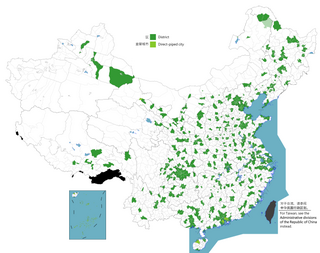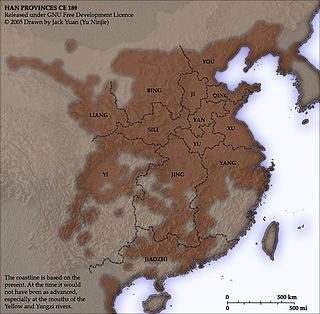
The Tujia, with a total population of over 8 million, is the 8th largest ethnic minority in the People's Republic of China. They live in the Wuling Mountains, straddling the common borders of Hunan, Hubei and Guizhou Provinces, and Chongqing Municipality.

The term district, in the context of China, is used to refer to several unrelated political divisions in both ancient and modern China.
Emperor He of Southern Qi ( 齊和帝) (488–502), personal name Xiao Baorong (蕭寶融), courtesy name Zhizhao (智昭), was the last emperor of the Chinese dynasty Southern Qi. He was put on the throne by the generals Xiao Yingzhou (蕭穎冑) and Xiao Yan in 501 as a competing candidate for the throne to his violent and arbitrary older brother Xiao Baojuan. In 502, with Xiao Baojuan having been defeated and killed and Xiao Yingzhou dead, Xiao Yan seized the throne from Emperor He and took the throne himself, ending Southern Qi and starting Liang Dynasty. Soon, Xiao Yan had the 14-year-old former Emperor He put to death.
The history of the administrative divisions of the Imperial China is quite complex. Across history, what is called 'China' has taken many shapes, and many political organizations. For various reasons, both the borders and names of political divisions have changed—sometimes to follow topography, sometimes to weaken former states by dividing them, and sometimes to realize a philosophical or historical ideal. For recent times, the number of recorded tiny changes is quite large; by contrast, the lack of clear, trustworthy data for ancient times forces historians and geographers to draw approximate borders for respective divisions. But thanks to imperial records and geographic descriptions, political divisions may often be redrawn with some precision. Natural changes, such as changes in a river's course, or loss of data, still make this issue difficult for ancient times.

Zhongxiang is a county-level city of Jingmen, central Hubei province, People's Republic of China. The name Zhongxiang means "Blessed with propitious omen", and was given to the city by the Jiajing Emperor in the Ming dynasty.
Huji or HUJI may refer to:
The Jingshan – Zhongxiang Campaign was a half-year-long struggle in Hubei between the nationalists and the communists for the control of Jingshan and Zhongxiang regions during the Chinese Civil War; it resulted in communist victory.
Tian Jun is a male Chinese rower, who competed for Team China at the 2008 Summer Olympics.
Jingzhou is a prefecture-level city in Hubei, China
Guizhou (贵州) is a province in southwestern China.
Anzhou or An Prefecture was a zhou (prefecture) in imperial China, centering on modern Anlu, Hubei, China. It existed (intermittently) from 550 until 1119, when the Song dynasty renamed it De'an Prefecture.
Yingzhou or Ying Prefecture (潁州) was a zhou (prefecture) in imperial China in modern northwestern Anhui, seated in modern Fuyang. During the later parts of the Qing dynasty it was known as Yingzhou Prefecture (潁州府). It existed (intermittently) from 528 until 1912.
Yingzhou or Ying Prefecture (應州) was a zhou (prefecture) in imperial China in modern Shanxi, China, seated in modern Ying County. It existed (intermittently) from the 9th century until 1912.

Yingzhou or Ying Prefecture was a zhou (prefecture) in imperial China in modern Hebei, China, seated in modern Hejian. It existed (intermittently) from 487 until 1108.
Junzhou or Jun Prefecture (均州) was a zhou (prefecture) in imperial China, seated in modern Danjiangkou, Hubei, China. It existed (intermittently) between 585 and 1912.

Yingzhou or Ying Prefecture was a prefecture (zhou) in imperial China centering on modern Yingde, Guangdong, China. It existed intermittently from 947 until 1195.










